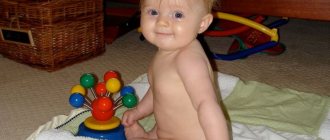Girls develop faster than boys, and children who are not overweight are more active than their well-fed peers.
At an appointment, pediatricians ask parents a question when the child is already 6 months old - “Is the child already sitting down?”, or ask them to sit your baby down for the convenience of examining him.
Children sit down at the age of 6-8 months, approximately when they begin to crawl. Basically, the child first gets on all fours, and from this position, they sit back on their buttocks, first holding onto the floor surface with 2 hands, then with one, and over time they remove their hands and sit on their own. With good abs, it is possible to sit down over a side, pushing off with one hand from the surface on which the child is located.
After this, mothers begin to worry and worry, wondering why their child still doesn’t sit up on his own? And how to teach a child to sit?
Teaching a child to sit is not at all difficult, because with normal development he will sooner or later learn everything. We will figure out when a child can sit and whether he should be helped in this matter.
Physical development at 6 months
A six month old baby is very different from a newborn. What a long way in his development he has come, how many skills he has acquired! Now he is not a helpless baby who just lies and looks at his parents. He can now do a lot of things himself.
Motor skills at 6 months:
- sits independently, without support;
- rolls over from stomach to back;
- moves around, rearranging his arms, tries to crawl, sometimes even stand up;
- takes toys in both hands and plays with them independently, examines them.
An active baby can no longer be left alone unattended. If earlier, at 4-5 months, it was still possible to put him in the middle of the bed and walk away for a couple of minutes, now you need to keep an eye on the little one - he is rapidly improving his motor skills. Today he still couldn’t move, and tomorrow he crawled onto the edge of the bed and almost fell.
Attempts to crawl most often begin with sliding along the floor on the stomach in the backward direction, the child pushes off the floor with his hands and moves back as far as his hands can reach.
The fingers are becoming more and more obedient, and it is already possible to pick up cubes and transfer them from one hand to another.
Neuropsychic indicators of a child at 6 months:
- carefully examines surrounding objects and people;
- turns towards sound, voice;
- reacts to his name;
- learns to eat from a spoon, removes food with lips;
- begins to speak: babbles, pronounces individual syllables.
Now, if a stranger, a stranger, takes the baby in his arms, most often the baby expresses his dissatisfaction quite clearly - he begins to whine and asks to be held back in his mother’s arms. It is at this age that the baby requires close attention and tries not to let his parents get away from him.
Often at this time the first baby teeth appear, which means it’s time to introduce complementary foods. You should start with microscopic portions - a sixth of a teaspoon of fruit puree or milk porridge. When teething, all toys are pulled into the mouth, so it is better to remove all soft, fragile toys from the baby’s reach. Leave them rubberized, durable and impossible to bite through.
The influence of articles on skill formation
At what months do girls start sitting? What about the boys? In physiological development, girls are usually ahead of boys.
However, for a very long time it was believed that early planting is much more dangerous for girls than for boys.
More precisely, not early planting as such, but non-compliance with safety rules.
Girls were considered more vulnerable, since any, even minor, pathologies in the formation of the pelvic bones could negatively affect the reproductive health of the future woman.
Today's pediatricians are not so categorical in this statement: evidence-based medicine does not have indisputable facts on this matter. For this reason, caution must be exercised towards both boys and girls equally.
Why does a child not sit at six months?
Despite the fact that the standards for the physical development of children at six months state that a child at this age should sit without support, not all children can do this. Pediatricians believe that a child does not owe anything, everything has its time. If a child does not sit at six months, it means that his time has not yet come. There are such calm, phlegmatic children who, by their temperament, are in no hurry.
Sometimes the reason lies in the baby’s excess weight, due to which he simply cannot sit down. Most often, the inability to sit is associated with muscle flaccidity when the child is not physically developed enough. In such a situation, it is necessary to consult an orthopedist and neurologist for advice. Having assessed the degree of lag, doctors will be able to prescribe strengthening procedures: a course of massage and physiotherapy.
Strengthening exercises
Checking readiness
You can determine whether a child is ready to learn a new skill by his behavior. Pay attention to three important factors:
- Age from 7 months, when the muscle corset is more or less formed and the spine is prepared.
- Emotional readiness - the little man is bored lying down, he wants to master new positions. If the desire to learn to sit up appears in a baby before six months of age, then you should not abuse the child’s potential, his spine is not yet ready for such loads.
- Physical readiness - the baby himself actively pulls his hands in the hope of catching the adult’s fingers, and having caught them, he raises his body towards you. Pull the baby holding your index fingers towards you. If he manages to lift himself a significant distance from the surface, then you can safely teach him to sit.
Help in crawling
Each baby begins to crawl in its own way. Some pull themselves up on their arms and crawl forward on their stomachs, others push off with their hands and crawl back. All this can be called “creeping”, the initial stage. Children try to carry out such movements at 4-5 months, lying on their stomachs. Later, as the muscles of the back and arms strengthen, the stomach lifts off the floor, the weight is transferred to the arms, and an exciting journey on all fours begins.
The importance of crawling in development:
- independent movement of the baby and training of the muscles of the back, arms, abs, neck;
- correct posture is formed, so crawling is an important stage of physical development on the path to independent walking;
- the child’s activity and cognitive ability significantly increase;
- harmonious development of the brain, the left and right hemispheres work together for proper coordination.
It is from the sixth month that the period of “crawling” begins - attempts to get on all fours, reach for the desired toy, crawling to the side or back.
Important! The ability to crawl is more important than the ability to sit. While sitting, the child gets tired quickly and cannot independently change his body position.
It is necessary to develop and strengthen muscles gradually, starting from birth. During the period of 1-2 months, the baby should learn to hold his head well; if this does not happen, you need to contact a neurologist for help. At 3 months, regularly do strengthening gymnastics that train the muscles of the back and neck; exercises on a fitball have proven to be very effective. At 4 months, the grasping skill is trained - offering toys, foam dumbbells and any other objects that a child’s hand can easily grasp. At 5 months it is necessary to learn to roll over on its side and spin around itself. Usually they take a child lying on his back by one arm and help him turn over, slightly pulling him to the side.
To answer the question why a child does not crawl at 6 months, it is necessary to correctly assess his physical readiness for this. If the baby does not have developmental delays, he should be encouraged to crawl. Place your favorite toy at a short distance from him and let him try to reach it. To help, you can create support for his feet with your hands, so it will be easier for him to push off. A very good way is based on imitation: lie down next to the baby on the floor and show how to crawl correctly. If the child is not crawling at 6 months, you can invite guests to the house with a small child who can already crawl. The baby will be given a visual demonstration of a crawling master class.
How to help crawl
Massage for babies
Massage for a six-month-old baby is combined with elements of gymnastics. The massage begins by stroking the arms from the palms up to the neck when the baby lies on his back.
Spread your arms apart, then bring them together on your chest. Lift up and lower down. Repeat several times.
Now you can massage the tummy around the navel clockwise. Make gentle stroking movements, repeating them several times. With both hands, from the center to the sides, make stroking movements of the chest towards the ribs.
Massage your baby's feet by doing a little exercise. Bend the legs first one by one, then simultaneously several times. Rub your baby's feet with your thumbs and massage each toe.
Now you can move on to the back. Turn the baby onto his stomach and make stroking movements on the back from bottom to top, from the sacrum to the neck. Then stroke the baby's back from the center to the sides. Finish the massage with a light tingle on the back.
Do an exercise to lift your torso from a lying position on your stomach. Let your baby's feet rest on you, grab his arms that are spread out to the sides and gently pull him up. Repeat several times.
It is better to do massage and gymnastics in the morning. This can be done between the first and second feeding (an hour after the first and an hour and a half before the second).
Before starting the procedures, be sure to remove the rings from your fingers and wash your hands. You can use baby massage oil for massage.
To make the activity enjoyable for your little one, talk gently to him, sing songs, read poetry, or turn on quiet, relaxing music.
How to teach a child to sit
You cannot force someone to sit. If your baby is unable to sit on his own, it means that the muscles have not yet become stronger. Forced loading will only cause harm and cause problems with the spine in the future. If the baby sits up on his own before reaching six months, it means he is ready, and it will not harm him. His sitting time will have to be limited - up to 1 hour per day is allowed.
If a boy and a girl are not sitting on their own at 6 months, it is strictly forbidden to:
- sit on soft pillows;
- move in a wheelchair;
- wear in carriers and slings in a sitting position;
- sit on your hands (allowed only in a reclining position on your knees).
Boys and girls can be taught to sit at the same age; the information that girls’ internal female organs do not form correctly due to early sitting is a myth.
A healthy child will learn to sit and stand on his own; parents only need to help him a little with this, says pediatrician E. Komarovsky.
that you can do at home yourself are very helpful
- The baby lies on a flat surface on his back. Mom holds out her index fingers to him and he tries to sit up to catch them. He should stay in this position for 5-7 seconds, then lie down on his back again. Repeat up to 10 times in one session.
- The child lies on his stomach. It is necessary to lift the child, hold him under the chest with one hand, and under the legs with the other. His legs should rest against his mother’s chest, while his buttocks and back should be tense. Stay in this position for 5 seconds.
How to teach a child to sit down correctly
Safety precautions
- When performing any exercises with your child, you must remember that he is still small, and the bones are still very fragile, so we do not force anything, we do not pull.
- As I already wrote at the beginning of our article, you should not try to drop off a child before 6 months, otherwise you will simply harm him.
- If your child sometimes cries when trying to sit up from a standing position. This is nothing to worry about; this can sometimes occur up to a year.
- There is no need to force the baby. By doing this you will only forcibly push him away from the process of sitting.
Good advice
For a child, any exercise should look like a game. No army discipline. If you could play some good, funny children's music while you exercise, that would be great. Also, do not forget to place his favorite toys near the child and come up with some exercises using them.










